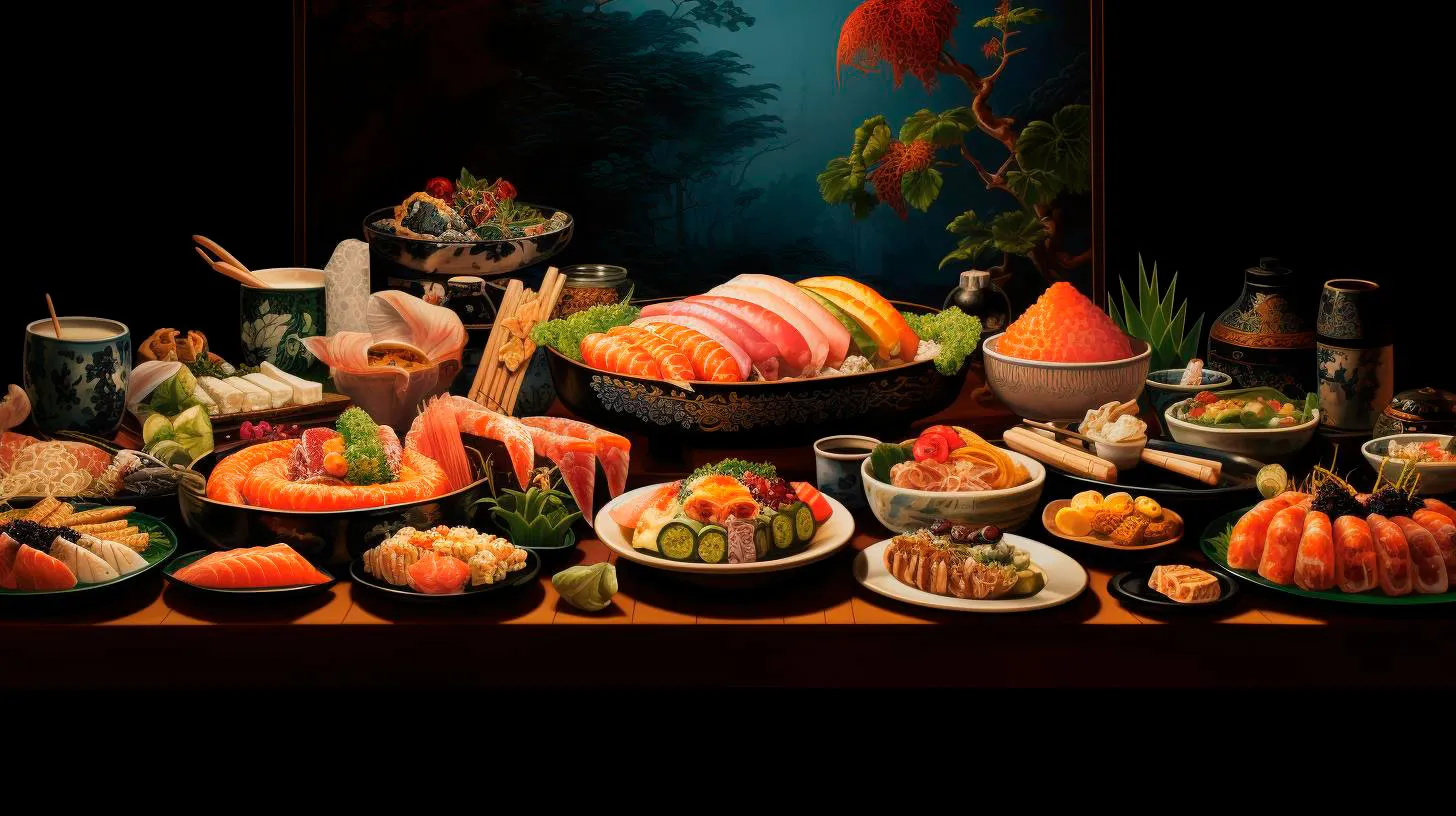Sushi and Sake: A Perfect Match for Culinary Connoisseurs
In this article, we will explore the intricate relationship between sushi and sake, shedding light on their individual merits and the magic that happens when they come together. So grab your chopsticks and get ready to embark on a journey through the realm of sushi and sake!
The Art of Sushi
Sushi, a traditional Japanese dish, has transcended cultural boundaries to become a global sensation. This culinary art form combines vinegared rice with various ingredients, including raw or cooked seafood, vegetables, and occasionally eggs. The expert craftsmanship behind sushi lies in the precise preparation and presentation of each component, resulting in a visually stunning and delectable masterpiece.
Sushi not only entices the senses but also offers numerous health benefits. Some of its advantages include:
- Rich in Omega-3 fatty acids: The combination of fish and seaweed found in sushi provides a healthy dose of Omega-3, which promotes heart health and reduces inflammation in the body.
- High in nutrients: Sushi ingredients, such as fresh fish, avocado, and vegetables, offer a rich source of vitamins, minerals, and antioxidants.
- Low in calories: Sushi is generally low in calories, making it a guilt-free indulgence for those mindful of their dietary intake.
- Improves digestion: Pickled ginger, a common accompaniment to sushi, aids digestion and helps cleanse the palate between different flavors.
With its blend of taste, aesthetics, and health benefits, sushi has firmly established itself as a staple in countless restaurants and culinary traditions worldwide.
The Elegance of Sake
When it comes to the perfect pairing for sushi, sake reigns supreme. Sake, often referred to as rice wine, is a traditional Japanese alcoholic beverage made from fermented rice. This aromatic elixir offers a myriad of flavors, ranging from delicate and fruity to bold and robust.
Here are some key takeaways on the allure of sake:
- Ancient Tradition: Sake has been enjoyed in Japan for centuries, with a rich cultural heritage dating back over 2,000 years.
- Diverse Varieties: Sake comes in various grades and styles, each offering a unique taste profile. From light and dry to full-bodied and sweet, there is a sake to suit every palate.
- Smooth and Refined: Sake’s remarkable smoothness and refined character make it an ideal companion for sushi. Its subtle flavors complement the delicate taste of sushi, elevating the overall dining experience.
- Perfect Serving Temperature: Sake can be enjoyed at different temperatures, allowing for a customized experience. Chilled sake enhances its crisp characteristics, while warm sake brings out its aromatic qualities.
With its elegant composition and versatility, sake adds an extra layer of sophistication to the sushi dining experience.
The Magic of Sushi and Sake Together
When sushi and sake are enjoyed together, they create a symphony of flavors that elevates the dining experience to new heights. Their complementary nature enhances each other’s unique characteristics, forming a perfect partnership that tantalizes the taste buds.
Here are some reasons why sushi and sake are a match made in culinary heaven:
- Enhanced Umami: The combination of sushi’s savory taste and sake’s subtle sweetness amplifies the umami factor, creating a harmonious and well-rounded flavor profile.
- Balanced Palate: Sushi’s delicate textures and varied flavors find balance and harmony when paired with the smooth and refined qualities of sake. They cleanse the palate between bites, intensifying the overall enjoyment of the meal.
- Cultural Fusion: Embracing sushi and sake offers a cultural experience. It allows diners to immerse themselves in the Japanese culinary traditions and taste the essence of a different culture.
Statistics reveal the growing popularity of sushi and sake worldwide:
- In the United States alone, sushi consumption has increased by 50% in the last decade.
- Sake exports from Japan reached a record high of 23,900 kiloliters in 2019, showing a significant global demand.
These figures indicate a thriving market for sushi and sake, driven by an ever-increasing number of enthusiasts.
Conclusion
Sushi and sake, individually remarkable, together sublime. This culinary ensemble beckons connoisseurs to embark on a sensory journey filled with flavors, textures, and cultural intrigue. From sushi’s artful presentation to the elegance of sake, every aspect is meticulously crafted to deliver an unforgettable experience.
So, the next time you find yourself yearning for an extraordinary dining adventure, indulge in the enchanting combination of sushi and sake. Your taste buds will thank you!
Mastering the Art of Balancing Flavors in Sushi and Sake Pairings
In this article, we explore the intricate dynamics of pairing sushi and sake to elevate your culinary journey to new heights.
Understanding the Essence of Sushi
Sushi, the iconic Japanese cuisine, is more than just raw fish and rice wrapped in seaweed. It embodies the essence of balance, precision, and artistry. Each sushi roll is carefully crafted to showcase a delicate mix of flavors and textures. From the silky freshness of sashimi to the subtle crunch of vegetables, sushi offers an array of taste sensations to be explored.
Key Takeaway:
- Sushi is a culinary delight that incorporates a wide variety of flavors and textures.
- It is a perfect canvas to experiment with different sushi and sake pairings.
- Appreciating the intricacies of sushi enhances the overall dining experience.
The World of Sake
Sake, often referred to as a rice wine, is a traditional Japanese beverage crafted with utmost precision. It is fermented from polished rice and water, resulting in a liquid that carries nuanced flavors and aromas. Sake ranges from light and refreshing to rich and robust, making it a versatile companion for sushi.
Key Takeaway:
- Sake is a fermented rice beverage with diverse flavor profiles.
- Understanding the different types of sake is essential for successful pairings.
- The flavor complexity of sake complements the intricacies of sushi.
The Art of Flavor Pairing
Pairing sushi and sake is an art that requires careful consideration of flavor profiles. The goal is to create a harmonious balance where the sushi enhances the sake, and vice versa. Misjudging the pairing can overpower or dampen the flavors, diminishing the overall experience. Here are some key considerations for achieving a perfect match:
- Weight and Body: Light sushi rolls, such as sashimi or vegetable rolls, pair well with lighter sake varieties like Ginjo or Daiginjo. For more robust sushi like tempura rolls, try pairing them with Junmai or Honjozo sakes.
- Sweetness: Sake’s sweetness can either contrast or complement sushi flavors. Sweeter sushi rolls, like those with eel or sweet sauces, pair well with dry sakes. On the other hand, delicate and subtly flavored sushi balances beautifully with sweeter sakes.
- Acidity: High acid sakes, like Kimoto or Yamahai, can cut through the richness of fatty fish like salmon or tuna, creating a perfect harmony on the palate.
- Temperature: Sake can be enjoyed warm or cold, with each option providing a different experience. Warmer sake tends to accentuate its savory notes and pairs well with heartier sushi options.
Key Takeaway:
- Pairing sushi and sake requires considering the weight, sweetness, acidity, and temperature of both elements.
- Experimenting with different combinations allows for a personalized and enriching dining experience.
- Understanding the flavor dynamics enhances the overall enjoyment of sushi and sake pairings.
Expanding Your Palette
As with any culinary journey, expanding your horizons is key to mastering the art of flavor balancing in sushi and sake pairings. Here are some additional suggestions to explore:
- Regional Pairings: Delve into regional variations of sushi and sakes, such as pairing fatty tuna sushi with Junmai Ginjo from Niigata prefecture in Japan.
- Modern Innovations: Embrace the creativity of modern sushi chefs who experiment with unique flavors and presentations. Pair their innovative creations with equally bold and adventurous sakes.
- Personal Preferences: Develop your own preferences by trying different combinations and noting what tantalizes your taste buds. Everyone’s palate is unique, and exploring your personal preferences is part of the journey.
Key Takeaway:
- Exploring regional pairings and modern sushi innovations widens your flavor horizons.
- Developing personal preferences allows for a tailored and enjoyable sushi and sake experience.
In conclusion, mastering the art of balancing flavors in sushi and sake pairings elevates your culinary journey to new heights. Sushi’s delicate mix of flavors and textures creates the perfect canvas for showcasing the nuances of sake. By understanding the essence of sushi, the diverse world of sake, and the art of flavor pairing, you embark on an enriching exploration of Japanese gastronomy. So, grab some sushi rolls, pour yourself a glass of sake, and embark on a gastronomic adventure that will delight your taste buds and awaken your senses.
Unlocking the Secrets of Sushi and Sake Harmony
Sushi: An Art Form on a Plate
Sushi, a traditional Japanese dish, is not just a meal but an art form on a plate. It incorporates vinegared rice with various ingredients such as raw or cooked fish, vegetables, and sometimes even tropical fruits. With its delicate balance of flavors, textures, and aesthetics, sushi is a feast for the senses.
The Different Types of Sushi
- Nigiri: Hand-formed sushi rice topped with ingredients like fish, seafood, or omelet.
- Maki: Sushi rolls wrapped in nori seaweed, filled with rice, fish, vegetables, and other select ingredients.
- Sashimi: Fresh slices of raw fish or seafood served without rice.
- Temaki: Hand-rolled sushi cones filled with rice, fish, and vegetables.
Each type of sushi offers a unique taste and texture profile, allowing for a diverse range of flavor combinations and culinary experiences.
Sake: Nectar of the Gods
Sake, often referred to as the nectar of the gods, is a traditional Japanese alcoholic beverage made from fermented rice. It boasts a rich and complex flavor profile, making it an ideal companion to sushi.
The Different Grades of Sake
- Junmai: Made only from rice, water, koji mold, and yeast, offering a pure and robust flavor.
- Ginjo: Crafted using rice that has been milled to at least 60%, resulting in a fruity and fragrant aroma.
- Daiginjo: The highest grade of sake made from rice milled to at least 50%, providing a delicate and refined taste.
- Honjozo: Similar to junmai sake but with a small amount of distilled alcohol added, creating a lighter and smoother flavor.
Each grade of sake has its distinct characteristics, allowing for a diverse range of flavor profiles that can enhance the sushi experience.
Unlocking the Harmony
When it comes to pairing sushi and sake, unlocking the perfect harmony is an art in itself. Here are some tips to help you navigate this culinary journey:
Consider the Taste Profiles
The key to a successful sushi and sake pairing lies in balancing the flavors. Sushi with fatty fish pairs well with fuller-bodied, rich sakes, while delicate sashimi or milder sushi options are complemented by lighter, more aromatic sakes. Consider the flavors of both the sushi and sake to achieve the desired harmony.
Experiment with Contrasting Flavors
Contrasting flavors can create a delightful dining experience. Pairing a dry sake with a rich, fatty sushi can create a palate-cleansing effect, while a sweeter sake can balance the saltiness of soy sauce or enhance the umami flavors of certain sushi ingredients.
Temperature Matters
The temperature at which sake is served can significantly impact its taste. Generally, colder sake pairs well with lighter sushi options, while a slightly warmer sake can enhance the flavors of bolder, more flavorful sushi varieties. Experiment with different temperatures to find your preferred pairing.
Key Takeaways
- Sushi and sake create a perfect culinary harmony.
- Understanding the different types and flavors of sushi and sake is crucial.
- Consider the taste profiles when pairing sushi and sake.
- Experiment with contrasting flavors and temperatures.
- Enjoy the unique experience of sushi and sake pairing.
Unlock the secrets of sushi and sake harmony, and indulge in a remarkable gastronomic journey that combines tradition, art, and exquisite flavors. Enter a world where sushi and sake dance together, creating an unforgettable dining experience.
Exploring the Exquisite World of Sushi and Sake Fusion
The Origins of Sushi and Sake
Sushi, originating in Southeast Asia, evolved into the iconic culinary artform we know today in Japan. It was initially a way to preserve fish by fermenting it with rice and salt. With time, the rice was no longer consumed, and sushi took the form of a delightful combination of raw fish, vinegared rice, and various toppings and fillings.
Sake, on the other hand, is a traditional Japanese rice wine that has been produced for over 1,000 years. It is made through a fermentation process where rice is polished, steamed, and then combined with yeast and water. The result is a complex beverage with a range of flavors and aromas.
The Perfect Fusion
The combination of sushi and sake creates a harmonious balance of flavors and textures. The delicate flavors of sushi, with its fresh fish, creamy avocado, and crunchy vegetables, pair perfectly with the subtle yet complex taste of sake. The umami-rich nature of sushi enhances the nuances of sake, creating an unforgettable gastronomic experience.
- Synergy of Flavors: Sushi and sake fusion is all about achieving a perfect balance of flavors. While sake enhances the taste of sushi, sushi complements the unique characteristics of each sake variety.
- Multiple Pairing Options: Sushi’s versatility allows for a wide range of sake pairings. From light and floral sakes to bold and robust varieties, there is a sake suitable for every sushi dish.
- Cultural Connection: Exploring sushi and sake fusion not only offers an exceptional culinary experience but also provides a glimpse into Japanese culture and traditions.
Experiences Worth Exploring
1. Sushi Omakase with Sake Pairing
Omakase, meaning “chef’s choice,” is an exceptional dining experience where the chef selects and prepares a unique sushi tasting menu. Pairing this with a sake tasting flight adds an extra dimension of flavor exploration. Savoring each piece of sushi while sipping complementary sakes is a true delight.
2. Sushi Burgers with Sake Cocktails
A contemporary twist on traditional sushi, sushi burgers have gained popularity in recent years. These handheld delights feature sushi ingredients sandwiched between rice buns. Pairing sushi burgers with sake cocktails, such as refreshing yuzu sake spritzers or sake margaritas, further elevates the experience.
3. Sushi and Sake Tasting Events
Attending sushi and sake tasting events allows you to expand your knowledge and appreciation for these culinary delights. Local restaurants and sake breweries often organize tastings, offering a chance to discover new flavors and learn about their preparation.
Key Takeaways
Sushi and sake fusion is a captivating culinary experience that brings together the art of sushi making and the flavors of sake. Some key takeaways from this exploration include:
- Understanding the origins of sushi and sake helps appreciate their cultural significance.
- The combination of sushi and sake creates a harmonious balance of flavors.
- Exploring different sake varieties and pairing them with specific sushi dishes enhances the dining experience.
- Participating in sushi and sake tasting events opens up opportunities to discover new flavors and expand your palate.
Embark on a fascinating journey as you explore the exquisite world of sushi and sake fusion. Whether you choose to indulge in a traditional sushi omakase or savor sushi burgers with sake cocktails, the combination is sure to leave a lasting impression.



